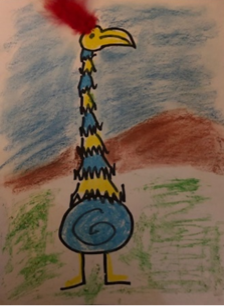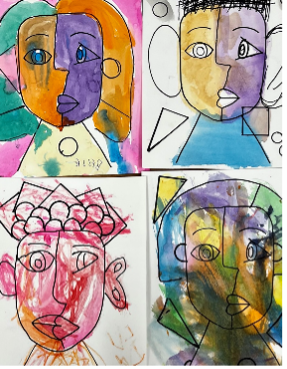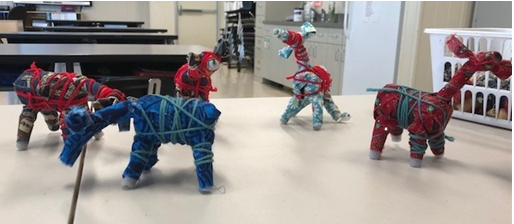Meet Ms. Juli Inagi, Beacon Day School's Arts Integration Teacher
- Ting Angeles
- Sep 2, 2022
- 4 min read
Updated: Oct 20, 2022
This month’s blog focuses on Arts Integration one of the hallmark programs at Beacon Day School and an interview with the teacher who leads the program, Ms. Juli Inagi.
About Ms. Juli Inagi
Ms. Juli has over 40-years of experience teaching special education. She holds multiple teaching credentials including a credential for teaching the severely handicapped and an arts specialist credential. Ms. Juli has taught at BDS since 2006 in a variety of capacities including being a part of the school leadership team. Ms. Juli will tell you that she’s tried to retire multiple times, but her love for the students, teaching and the arts brings her back to school every year. She considers teaching art at Beacon the Best Retirement Job Ever.

What is Arts Integration?
Arts Integration is the teaching of different subject matter and skills through the education and application of all forms of art. At BDS an art project is never just an art project. Each project is designed to teach students a variety of academic skills and knowledge. Importantly, arts integration allows every student to express themselves and be recognized for their artistic accomplishments.
How do you develop an art project?
I love the art masters and I love certain periods of art. In doing research for developing the Arts Integration curriculum I came across a timeline for teaching art history from the Stone Age to Contemporary Art. I’ll then identify an artist or an artistic style from that specific period and come up with a project based on the artist or style.
What’s an example?
One project was focused on the paintings of the Impressionist Period. The project for this art period was inspired by the artist Claude Monet. The students used Crayola markers to draw a field of lupin flowers and used a spray bottle to create the blurred effect of the impressionist style of light and color. Doing art projects requires a variety of attending skills. The students were able to follow my model with the support of their behavior interventionists. Then many students love splattering water, so after they colored with markers, the experience of spraying their paper was truly a treat.

Who are some of the artists that have inspired art projects?
When teaching Surrealism, I used Dr. Seuss, since many students know his books and some of the amazing birds that are a part of his stories. We drew birds with long necks and legs and glued on feathers. For the Abstract Expressionists I introduced the students to Giuseppe Arcimboldo . We talked about the idea of making something abstract and used fruits and vegetables to make abstract faces. In discussing Cubism, I taught the students about Pablo Picasso and how he approached painting faces. Another artist we modeled was Andy Warhol and by taking pictures of each student’s face, printed it out in black and white. The students could then use paint colors to create a Pop Art versions of their face. There are also artists with disabilities that have inspired art projects, like an artist with Downs Syndrome, Judith Scott an outsider artist who does incredible sculptures with fabric and string. We made animal sculptures.
Where do you get the ideas for your projects?
I’m always looking at opportunities to make art. Last month my husband was cutting branches off a tree in our yard. Seeing the branches gave me an idea and I had him cut the branches into small sections so each student would have a branch. I brought the branches to school for a project where we strung fabric on the branches. This project was inspired by Philippa Lawrence a contemporary Irish artist known for turning pieces of trees into art.

What are some of the unique ways students put themselves into a project?
In the fabric tree project one of the students loves to see fabric and string move in the wind. The student made their tree so that when it was put in front of a fan the fabric would flow in the breeze. Some students like to draw, or they like to make puppets. If a project doesn’t involve drawing or puppet making, I’ll encourage students to complete a portion of the assigned project and then allow time for “free art” where students can complete an art project using their creative liberties. One student went through a phase where he would only participate by making circles. So we modified the project to include circles. Part of what students learn is how to find balance between following directions and using their own creativity. We’ve also discovered materials or projects that are reinforcing for students. For example we did bubble art and learned that several students enjoyed blowing or popping bubbles, and bubbles are now available as reinforcers for those students’ work.
Are there many budding artists at BDS?
There are definitely artists at BDS. Students that find unique ways to express themselves through art. . When making the Philippa Lawrence trees, one student who is non verbal but uses a device to speak, was very specific in his requests asking for glue and various materials to create his sculpture, making it truly his own. Another student is so precise in his art. He will often ask to keep the materials so that he can finish the project to his liking. His finished projects are exceptional and I’ve asked to take pictures of many of his projects.
Any students whose work inspire you?
Students inspire me all the time. The student that makes puppets out of anything is also able to use any materials that I supply for the project of the day and create his own unique art piece. Another student uses my sample of the art project and always makes it his own. He also draws characters and builds stories about the characters that he creates. Many students are attracted to the sensory aspect of art and will use the glue or paint with their fingers to express themselves. I’m always blown away by the quality of art that BDS students create.
What do you enjoy most about teaching art?
When I come into a classroom and the students are enthusiastic about doing art. I love seeing the pride they feel when they show off their projects. Every student’s art project is recognized and celebrated. No matter what anything looks like it is the student’s art, it is their accomplishment.













z